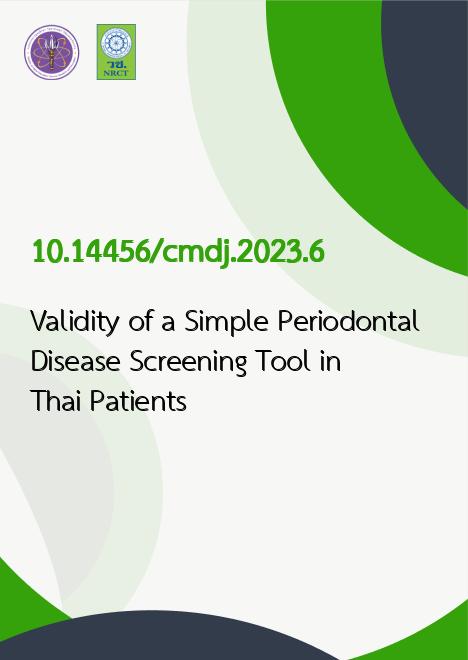
|
Validity of a Simple Periodontal Disease Screening Tool in Thai Patients |
|---|---|
| รหัสดีโอไอ | |
| Creator | Panwadee Bandhaya |
| Title | Validity of a Simple Periodontal Disease Screening Tool in Thai Patients |
| Contributor | Tanchanok Bureesri, Chidchanok Ruengorn, Supatra Sang-in |
| Publisher | Faculty of Dentistry, Chiang Mai University |
| Publication Year | 2566 |
| Journal Title | Chiang Mai Dental Journal |
| Journal Vol. | 44 |
| Journal No. | 1 |
| Page no. | 53-64 |
| Keyword | periodontitis, questionnaire, sensitivity and specificity, Thai |
| URL Website | http://www.dent.cmu.ac.th/cmdj/frontend/web/?r=site/index |
| Website title | Chiang Mai Dental Journal |
| ISSN | 2773-921x (Print); 2822-0544 (Online) |
| Abstract | Objectives: To develop and evaluate the validity of a self-reporting questionnaire for periodontitis in the Thai population.Methods: A cross-sectional analytical study was performed in a group of 300 Thais aged 19-85 years old at the Faculty of Dentistry, Chiang Mai University. Each participant took a questionnaire and received a periodontal status evaluation. Participants were classified into three severity groups using the Centers for Disease Control and Prevention, in partnership with the American Academy of Periodontology (CDC-AAP) criteria. Multivariable ordinal logistic regression analysis was used to achieve the final model. The scoring system was also developed.Results: One hundred patients of each severity group were recruited. Significant predictors in the final model included age, gender, bleeding gums, tooth mobility, dental flossing, dental check-up frequency, diagnosis by a dentist, and individual assessment of periodontitis. The total derived scores identified the severity group of patients into no/mild, moderate, and severe periodontitis. Our model predicted severity groups correctly in 65.7% of patients, while giving an underestimation of 19.3% and an overestimation of 15%. The area under the receiver operating characteristic curves (AuROCs) equal to 0.92 and 0.80 discriminated moderate and severe from no/mild periodontitis, and severe from no/mild and moderate periodontitis, respectively.Conclusions: Our periodontal disease screening tool demonstrates adequate accuracy. Its validity should be evaluated in other populations. |